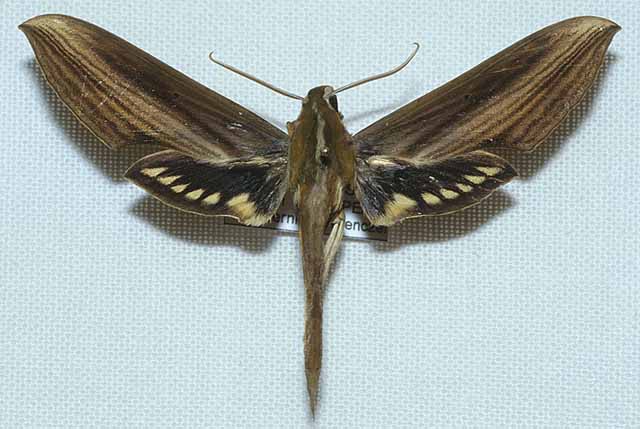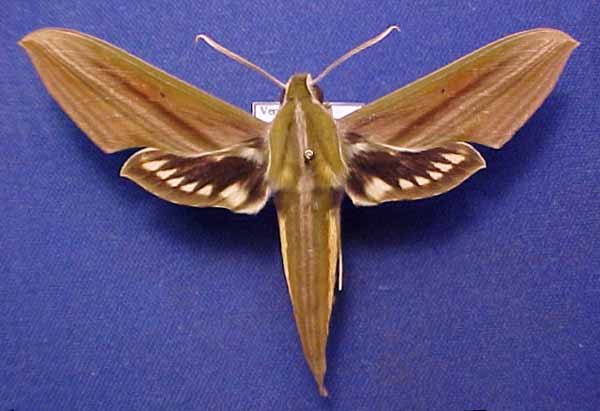Xylophanes resta
|
|
Updated as per
AN ANNOTATED CHECKLIST OF THE SPHINGIDAE OF BOLIVIA, October 2007
Updated as per More, Kitching and Cocucci's Hawkmoths of Argentina 2005, October, 2007
Updated as per CATE Sphingidae (Venezuela, Peru, Ecuador, Bolivia, ?? western Argentina); May 1, 2011
Updated as per personal communication with Ezequiel Bustos (Shilap revta. lepid. 43 (172) diciembre, 2015, 615-631 eISSN 2340-4078 ISSN 0300-5267), January 4, 2016
|
Xylophanes resta
zail-AH-fan-eesMRES-tuh
Rothschild & Jordan, 1903

Xylophanes resta male, Peru, courtesy of
Hubert Mayer
copyright.
This site has been created by
Bill Oehlke at oehlkew@islandtelecom.com
Comments, suggestions and/or additional information are welcomed by Bill.
TAXONOMY:
Family: Sphingidae, Latreille, 1802
Subfamily: Macroglossinae, Harris, 1839
Tribe: Macroglossini, Harris, 1839
Genus: Xylophanes Hubner [1819] ...........
Species: resta Rothschild & Jordan, 1903
|
MIDI MUSIC
.....It's a Wonderful World.....
copyright C. Odenkirk
ON.OFF
<bgsound src="world.mid" LOOP=FOREVER>
|
DISTRIBUTION:
Xylophanes resta moths
(wingspan: mm) fly in
Venezuela (specimen type locality) and south to
Ecuador;
Peru: Pasco: Oxapampa: Charapa; Puno: Carabaya: Santo Domingo; and
Bolivia: Santa Cruz: Manuel María
Caballero, San Juan del Potrero; La Paz: Murillo, Valle de Zongo;
Sud Yungas Yanacachi; Murillo, Zongo-Pacollo;
Cochabamba.
Specimens attributed to Argentina are more likely Xylophanes anubus, although Ezequiel Bustos reports them in Tucuman, Argentina.
CATE: "Intermediate in appearance between Xylophanes aristor and Xylophanes tersa. Forewing somewhat broader than Xylophanes tersa;
length: 36-41 mm.
"Tegula with a weakly developed golden medial line. Upperside of thorax with a grey medial band, bordered laterally and divided medially by brown lines, which is
continued along the abdomen but becoming faint after first two abdominal segments. Golden-yellow lateral stripes on abdominal segments 3 to 6 more distinct than in
Xylophanes tersa, with a patch of pale hairs and black patch anterior to it.
"Outer spur of midtibia longer than inner. Abdominal sternites without distinct lines.
"Forewing upperside with a characteristic brown tone; first postmedian line very strong basally but disappearing towards the apex; second postmedian line fused
basally with the first (as in Xylophanes eumedon); fourth postmedian line less than half the width of the first.
"Forewing (and hindwing) underside brighter than in Xylophanes tersa, the brown markings consequently more prominent; a straight brown line, in some places
indistinct, crossing the wing parallel to distal margin, crossing M3 about 1.5–2 mm. from discal cell; marginal area not, or only slightly, darker than disc;
a weakly defined yellow costal patch present apically (similar to that in Xylophanes titana).
"Hindwing upperside with pale yellow spots of median band larger than in Xylophanes tersa, the more distal closer to the margin; all separate apart from those from
CuA2 to 2A; small marginal spot at anal angle.
"Marginal area of hindwing underside divided by the veins, which are pale orange."
The pronunciation of scientific names is
troublesome for many. The "suggestion" at the top of the page is
merely a suggestion. It is based on commonly
accepted English pronunciation of Greek names and/or some
fairly well accepted "rules" for latinized scientific names.
The suggested pronunciations, on this page and on other pages,
are primarily put forward to assist those who hear with internal
ears as they read.
There are many collectors from different countries whose
intonations and accents would be different.
Jean Marie Cadiou writes, "When I say "Xylophanes" in English I
pronounce it something like "Zailophanees", with the emphasis on the
"o". The French pronounce it differently, something like
"Kzeelophaness" with no emphasis, and the Germans yet in a
different way..."
Some of the early describers/namers chose genus
and species names indicating some character of the insect, but more
often, they simply chose names from Greek or Roman mythology or
history.Those species names which end in "ensis" indicate a
specimen locale, and those which end in "i", pronounced "eye", honour
a contempory friend/collector/etc.
"Xylophanes" sounds like it is from Greek mythology,
and resta, in Greek, means the remainder or leftover.

Xylophanes resta courtesy of John Vriesi.
FLIGHT TIMES:
Xylophanes resta adults probably
brood continuously.
ECLOSION:
Pupae probably wiggle to surface from subterranean chambers just prior to eclosion.
SCENTING AND MATING:Females call in the males with a pheromone released from a gland at the tip of the
abdomen. Males come in to lights very readily, but females are seldom taken in that way.
EGGS, LARVAE, PUPAE:
Larvae probably feed on
plants of the Rubiaceae and Malvaceae families.
Moths emerge approximately one-two months after larvae pupate.

Xylophanes resta male, Venezuela,
on my home computer only.
Use your browser "Back" button to return to the previous page.
Goto Main Sphingidae Index
Goto Macroglossini Tribe
Goto Central American Indices
Goto Carribean Islands
Goto South American Indices
Goto U.S.A. tables


